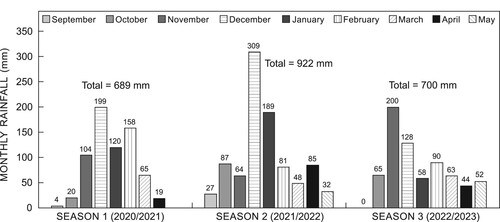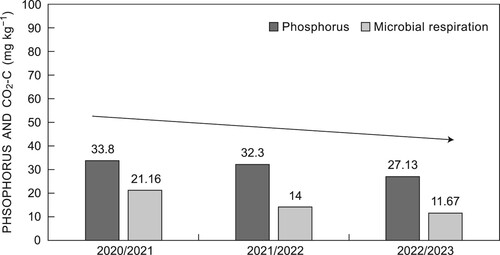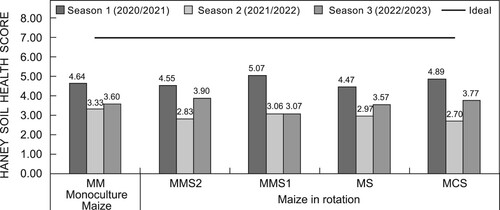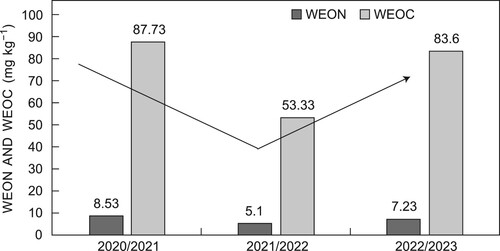Abstract
Soil health is an important aspect of sustainable agriculture. By maintaining soil health, crop yields can be consistently successful without negatively affecting the environment. The objective of this study was to evaluate the effects that different cropping systems have on soil health in the north-western Free State region. The cropping systems focused on maize production, with soybean and cover crop included as rotational crops and monitored for three consecutive seasons. Soil samples were taken seasonally and their physical, chemical and biological properties, as well as the subsequent soil health score, were measured using the Haney Soil Health Test (HSHT). Results from the HSHT were statistically analysed and showed that there was no statistically significant interaction effect between cropping systems and season on soil properties, nor on the subsequent soil health score. These findings suggest that soybean and cover crop rotations with maize have the potential to naturally maintain soil health in a condition similar to those subjected to an artificially fertilised monoculture of maize. In addition, season variation influenced soil health irrespective of cropping system. Therefore, including soybean and cover crops in cropping systems with maize can be a means of promoting sustainable agriculture in the north-western Free State region, when seasonal variation and inherent soil properties are considered.
The concept of soil health emerged in the 1990s and has seen regained interest with the recent emphasis on sustainable agriculture (Lehmann et al. Citation2020; Magdoff and Van Es Citation2021). The definition of “the continued capacity of a soil to function as a vital living ecosystem that sustains plants, animals, and humans” stresses its importance in our life support system (Ribeiro et al. Citation2018; Lehmann et al. Citation2020; Norris et al. Citation2020; Strauss et al. Citation2021). Soil health is promoted when all three of its components (physical, chemical, and biological) are optimal (Magdoff and Van Es Citation2021). Soil is physically healthy when sufficient volumetric aggregate stability allows water infiltration, limits surface runoff and provides adequate aeration (Cardoso et al. Citation2013). The volumetric aggregate stability, which encapsulates organic matter (OM), should be more than 45% (Sundermeier et al. Citation2017), while there should be at least 3% OM in soil (Magdoff and Van Es Citation2021). Soil must be able to sufficiently absorb, release and transform essential nutrients including nitrogen (N), phosphorous (P) and potassium (K). In order to obtain ideal nutrient measurements, the pH of the soil should be slightly acidic (5.50–6.50) (Morgan et al. Citation2005; Hinsinger et al. Citation2009; Opala et al. Citation2018). Furthermore, if the soil is healthy, biodiversity is increased and beneficial organisms are active, which stimulates plant growth (Magdoff and Van Es Citation2021). The greater the microbial respiration (measured as CO2-C) soils produce, the more abundant and active is the microbial life within them (Magdoff and Van Es Citation2021).
The north-western Free State region in South Africa is a semi-arid region that is dominated by extremely sandy soils (Beukes et al. Citation2019; Strauss et al. Citation2021). Only about 1–2% of the soil is made up of silt, while the clay content is normally less than 10% in the A-horizon and less than 15% in the B-horizon (Nortjè and Laker Citation2021). These sandy soils are characterised by low nutrient and fertility status and are vulnerable to erosion and compaction (Beukes et al. Citation2019; Nortjé and Laker Citation2021; Strauss et al. Citation2021). Wind erosion is especially problematic during August and September, removing topsoil and nutrients (Strauss et al. Citation2021). Cultivation leads to compaction and destruction of soil aggregates, which further contributes to low nutrient status and reduced water content for crop production (Magdoff and Van Es Citation2021; Nortjè and Laker Citation2021). It is therefore important to use agricultural management practices that conserve or improve soil health.
Maize (Zea mays L.) production is dominant in the area and is normally grown as a monoculture system (Loubser and Nel Citation2004; Nortjè and Laker Citation2021). However, the combination of maize with soybean (Glycine max (L.) Merr.), a leguminous crop, has been recognised for its commercial potential and its ability to fix atmospheric N in symbiosis with Rhizobium bacteria (Coskan and Dogan Citation2011; Acevedo-Siaca and Goldsmith Citation2020). It has been suggested that including a cover crop mixture as a third crop improves the cropping system’s productivity (Magdoff and Van Es Citation2021; Smit et al. Citation2021). Since the success of cropping systems appears to be site-specific (Nortjè and Laker Citation2021), the key is to find cropping systems ideal for the north-western Free State region. As part of identifying ideal cropping systems, the objective of this study was to monitor soil health and its properties in different cropping systems.
The study was conducted on the farm Christinasrus in the district of Wesselsbron in the north-western Free State region. A trial comparing different cropping systems to monoculture maize (MM) was established. Cropping systems included Maize–Maize–Soybean (MMS), Maize–Soybean (MS) and Maize–Cover crop–Soybean (MCS). The MMS system was split into MMS1 and MMS2 to distinguish between the first (MMS1) and second (MMS2) season of maize. The cover crop mixture was made up of 60% grasses (sorghum and pearl millet) and 40% legumes (Dolichos and cowpeas).
A randomised complete block design with three replicates was used for the trial layout (). There were 27 plots in total, each being 80.0 m × 24.4 m in size. Cropping systems were assigned to plots and each crop within each system, representing a different stage, was assigned to a plot to be able to distinguish between seasonal and rotational effects. The trial was monitored for three consecutive seasons: 2020/2021, 2021/2022 and 2022/2023.
Table 1: Plot design of trials on the farm Christinasrus for three consecutive seasons
The trial plots were prepared through the practice of rip-on-row (as per the farmer's preference) at a depth of 0.75 m in August or September of each season. Trials were planted in December, after pre-plant fertilisation. Pre-plant fertiliser consisted of 100-140 kg urea ha−1. Maize plots were fertilised again at planting and top-dressed. This resulted in the addition of 116–135 kg ha−1 N, 12–16 kg ha−1 P and 5–9 kg ha−1 K per season. Soybean and cover crop received no additional fertiliser. Maize and soybean plots were sprayed with round-up (glyphosphate) for the control of weeds. All field actions were carried out with commercial equipment. No biomass was removed or utilised by any farm animals.
Rainfall was measured manually using a rain meter at the trial location and the distribution is shown in . A favourable rainfall season was experienced during Season 1, with a total of 689 mm measured at the trial location from September 2020 to May 2021. Season 2 (2021/2022) had a very wet start compared to the previous season, with 309 mm of rain measured in December 2021 alone (seasonal total of 922 mm). In Season 3 there was more widespread rainfall with 700 mm measured between September 2022 and May 2023.
Figure 1: Rainfall distribution over Christinasrus, Season 1 (2020/2021, Season 2 (2021/2022) and Season 3 (2022/2023), respectively

Soil samples were collected from all maize plots in the trial during each season. The samples were taken approximately 100 days after planting and collected at a depth of 0–150 mm. Three samples were taken randomly within each maize plot, 200 mm from the plant row, and combined to form a composite sample. Soil properties of 15 composite samples were measured and integrated according to the Haney Soil Health Test (HSHT) to obtain a soil health score for each season (Ward Laboratories Inc. Citation2019; Regen AgLab Citation2021) ().
Table 2: Soil properties measured and integrated to obtain an overall soil health score using HSHT
The HSHT takes a different approach to traditional methods of evaluating soil health by focusing on soil as a dynamic living system, rather than just physical or chemical processes. (Haney et al. Citation2018). Haney et al. (Citation2018) highlights the importance of including the biological aspect into the soil health score. Therefore, the HSHT not only estimates plant available N, P, and K, but also provides an indication of soil health with respect to nutrient and C cycling (Haney et al. Citation2018).
The HSHT uses an H3A (Haney, Haney, Hossner and Arnold) extractant to measure plant available nutrients including N (NH4–N, NO3–N), P and K (Chu et al. Citation2019; Singh et al. Citation2020). This extractant is made up of organic acids (citric acid, oxalic acid and acetic acid), which mimic plant root exudates better than other extractants (Haney et al. Citation2018; Singh et al. Citation2020). Since the majority of nutrient cycling is due to a natural drying – rewetting effect (rainfall and irrigation), water extracts are also investigated to better represent the natural environment (Haney et al. Citation2018). The water extractable organic N (WEON) is the active organic soil N (Haney et al. Citation2018). The water extractable C (WEOC) reflects the quality of soil organic C as it provides the energy source for soil microbial activity (Haney et al. Citation2018). Therefore, WEOC estimates the active pool of soil C (Haney et al. Citation2018). This HSHT approach considers the WEOC : WEON ratio to be a more sensitive indicator of microbial activity than the traditional total C:N ratio (Chu et al. Citation2019).
An important factor in the HSHT is the microbial respiration, measured as CO2-C (Chu et al. Citation2019). The CO2-C released by soil microbes in 24 hours after the soil has been dried and rewetted is an indicator of soil respiration, and consequently microbial activity (Haney et al. Citation2018; Singh et al. Citation2020). The properties measured by the HSHT are integrated using Haney’s formula to obtain an overall soil health score as related to nutrient and C cycling. (Haney et al. Citation2018; Ward Laboratories Inc. Citation2019). The resulting score can range between 0 and 50, with a higher score meaning better soil health (Haney et al. Citation2018). Most soils do not score more than 30, while scores below seven are regarded as low (Singh et al. Citation2020).
Data from the HSHT was cleaned and prepared for Statistical Package for the Social Sciences (SPSS) version 29 (IBM Citation2023), where it was further analysed using descriptive and inferential statistics. Descriptive statistics included measures of central tendency and were represented as mean ± standard deviation. Inferential statistics included two-way analysis of variance (ANOVA), which were run to determine if there was a statistically significant interaction effect of cropping system and season on individual soil properties as well as overall soil health. Assumption testing, which included testing for outliers, normal distribution, and homogeneity of variances, was conducted before the ANOVA was run. Statistical significance was accepted at p ≤ 0.05.
illustrates the mean measurements and ANOVA results of soil properties and subsequent soil health score for each cropping system in each season as determined by the HSHT. Many soil properties and the subsequent soil health score were affected by season but not cropping system, with no interaction between these factors. Although this is not what was expected, the fact that cropping systems did not affect soil health is not an isolated case. Studies by Bavougian et al. (Citation2019) and Roper et al. (Citation2017) also found that soil health scores were not sensitive to management changes, including crop rotations. However, the fact that the monoculture maize received more fertiliser over time than maize rotated with soybean and cover crops, without significantly affecting soil health, could be an indication that by incorporating these crops, nutrient levels can be maintained naturally. Soybean is able to fix atmospheric N in symbiosis with Rhizobium bacteria (Coskan and Dogan Citation2011; Acevedo-Siaca and Goldsmith Citation2020). Similarly, the legumes in the cover crop are also able to act as a source of nitrogen (Fageria et al. Citation2005).
Table 3: Mean measurements ± standard deviation of three replicates, ANOVA results of soil properties, and subsequent soil health score for each cropping system in each season
The role that seasonal variation (mainly rainfall) plays on soil health was evident throughout the study. Many studies show that there is a seasonal effect on soil health (Mitchell et al. Citation2017; Babur and Dindaroglu Citation2020; Sharma et al. Citation2020; Sherbine et al. Citation2023). With the prediction of more extreme weather in the future (Chemura et al. Citation2022) it is important to take note of these effects. Three different significant seasonal trends were identified in this study. The first was an increase in measured values over the duration of the study. This was seen with soil pH (H2O) and could be due to the application of lime before the onset of the trial, which is one of the most common practices to reduce soil acidity (Li et al. Citation2019), as well as salts in the topsoil being diluted due to the wet conditions (Rengel Citation2011).
The second trend identified was a decrease in measured values of total P and CO2-C over the study period (). This could be linked to pH, as a higher pH is associated with constraints in P (Rengel Citation2011). The variation in P is related to the magnitude of soil respiration and could have been further suppressed by the anaerobic conditions caused by the heavy rainfall of the Season 2 (2021/2022) (Parent et al. Citation2008; Cusack et al. Citation2019; Magdoff and Van Es Citation2021). The kinetic energy of raindrops causes surface sealing and crust formation which reduce soil infiltration (Vaezi et al. Citation2017).
Figure 2: Seasonal trend for total P and microbial respiration (CO2-C), measured as Mg kkg−1, over the duration of the study

The third, and most common, trend was a significant decrease in measured values of organic components from Season 1 (2020/2021) to Season 2 (2021/2022), with an increased value in the third season (2022/2023). The OM is generally low in sandy soil but in our study it was further degraded by the anaerobic conditions caused by the rain intensity and duration of Season 2 (2021/202) (Horneck et al. Citation2011). Sitthaphanit et al. (Citation2009) explains that when rainfall intensity is high, decomposition occurs too quickly, causing OM and nutrients to be lost through leaching, rather than being released slowly into the soil. This results in lower WEON and WEOC levels, which are key determinants of the overall soil health score. The more widespread rainfall in the Season 3 (2022/2023) allowed some physical, chemical and biological properties to recover () due to their ability to withstand short-term fluctuations (Turner et al. Citation2015) and because the surface sealing and crust formation was less severe (Vaezi et al. Citation2017). These improvements resulted in a 17% increase in overall soil health from Season 2 (2021/2022) to Season 3 (2022/2023) ().
Figure 4: Haney soil health scores in each cropping system for Season 1 (2020/2021), Season 2 (2021/2022) and Season 3 (2022/2023). MMS = Maize–Maize–Soybean, MS = Maize–Soybean, MCS = Maize–Cover crop–Soybean. The MMS system was split into MMS1 and MMS2 to distinguish between maize Season 1 (MMS1) and maize Season 2 (MMS2)

In conclusion, this study showed that soybean and the legumes incorporated in cover crops are able to naturally maintain soil health at levels which are similar to those of soils exposed to an artificially fertilised monoculture of maize, therefore minimising the need for fertiliser application. This is a promising sign for the incorporation of crop rotation systems as a means of sustainable agriculture in this area. In addition, with the prediction of more extreme weather in the future, it is important to note that while recovery rates of different soil properties vary after intense, high rainfall, the overall soil health is generally weakened by such events. Seasonal variation (especially rainfall intensity and duration) in combination with inherent soil properties are important determinants of soil health in the region.
Acknowledgements
The authors would like to thank the Department of Higher Education and Training (DHET), South Africa for their financial contribution towards the study. The Sandy Soils Development Committee (SSDC) is also thanked for the access to field trials and data.
References
- Acevedo-Siaca L, Goldsmith PD. 2020. Soy-maize crop rotations in sub-Saharan Africa: A literature review. International Journal of Agronomy 1: 1–14.
- Babur E, Dindaroglu T. 2020. Seasonal changes of soil organic carbon and microbial biomass carbon in different forest ecosystems. Environmental Factors Affecting Human Health 1: 1–21.
- Bavougian CM, Shapiro CA, Stewart ZP, Eskridge KM. 2019. Comparing biological and conventional chemical soil tests in long-term tillage, rotation, N rate field study. Soil Science Society of America Journal 83: 419–428.
- Beukes DJ, Nel AA, Trytsman G, Steenkamp S, Rhode OHJ, Abrahams AM, van Staden P, Marx F, van Zyl B. 2019. Investigating the impacts of conservation agriculture practices on soil health as key to sustainable dry land maize production systems on semi-arid sandy soils with water tables in the North Western Free State. Annual progress report to The Maize Trust, Pretoria.
- Cardoso E, Vasconcellos R, Bini D, Miyauchi M, Santos C, Alves P, Paula A, Nakatani A, Pereira JM, Nogueira M. 2013. Soil health: Looking for suitable indicators. What should be considered to assess the effects of use and management on soil health? Scientia Agricola 70: 274–289.
- Chemura A, Nangombe SS, Gleixner S, Chinyoka S, Gornott C. 2022. Changes in climate extremes and their effect on maize (Zea mays L.) suitability over Southern Africa. Frontiers in Climate 4: 1–14.
- Chu M, Singh S, Walker FR, Eash NS, Buschermohle MJ, Duncan LA, Jagadamma S. 2019. Soil health and soil fertility assessment by the Haney soil health test in an agricultural soil in west Tennessee. Communications in Soil Science and Plant Analysis 50: 1123–1131.
- Coskan A, Dogan K. 2011. Symbiotic nitrogen fixation in soybean. Soybean Physiology and Biochemistry 307: 167–182.
- Cusack DF, Ashdown D, Dietterich LH, Neupane A, Ciochina M, Turner BL. 2019. Seasonal changes in soil respiration linked to soil moisture and phosphorus availability along a tropical rainfall gradient. Biogeochemistry 145: 235–254.
- Fageria NK, Baligar VC, Bailey BA. 2005. Role of cover crops in improving soil and row crop productivity. Communications in Soil Science and Plant Analysis 36: 2733–2757.
- Haney RL, Haney EB, Smith DR, Harmel RD, White MJ. 2018. The soil health tool – Theory and initial broad-scale application. Applied Soil Ecology 125: 162–168.
- Hinsinger P, Bengough AG, Vetterlein D, Young IM. 2009. Rhizopshere: Biophysics, biogeochemistry and ecological relevance. Plant Soil 321: 117–152.
- Horneck DA, Sullivan DM, Owen JS, Hart JM. 2011. Soil test interpretation guide. Oregon State University, Corvallis.
- IBM. 2023. IBM SPSS Statistics (version 29.0.0, 03 March 2023). Armonk: International Business Machines Corporation.
- Lehmann J, Bossio DA, Kögel-Knabner I, Rillig MC. 2020. The concept and future prospects of soil health. Nature Reviews Earth and Environment 1: 544–553.
- Li Y, Cui S, Chang SX, Zhang Q. 2019. Liming effects on soil pH and crop yield depend on lime material type, application method and rate, and crop species: a global meta-analysis. Journal of Soils and Sediments 19: 1393–1406.
- Loubser HL, Nel AA. 2004. Productivity and stability of grain yield in maize and sorghum as affected by rotational cropping systems in the North Western Free State. South African Journal of Plant and Soil 21: 80–84.
- Magdoff F, Van Es H. 2021. Building soils for better crops: Ecological management for healthy soils. University of Maryland: Sustainable Agriculture Research and Education Program.
- Mitchell JP, Shrestha A, Mathesius K, Scow KM, Southard RJ, Haney RL, Schmidt R, Munk DS, Horwath WR. 2017. Cover cropping and no-tillage improve soil health in an arid irrigated cropping system in California’s San Joaquin Valley, USA. Soil and Tillage Research 165: 325–335.
- Morgan JAW, Beinding GD, White PJ. 2005. Biological costs and benefits to plant-microbe interactions in the rhizosphere. Journal of Experimental Botany 56: 1729–1739.
- Norris CE, Bean GM, Cappellazzi SB, Cope M, Greub KL, Liptzin D, Rieke EL, Tracy PW, Morgan CL, Honeycutt CW. 2020. Introducing the North American project to evaluate soil health measurements. Agronomy Journal 112: 3195–3215.
- Nortjè GP, Laker MC. 2021. Soil fertility trends and management in conservation agriculture: A South African perspective. South African Journal of Plant and Soil 38: 247–257.
- Opala PA, Odendo M, Muyekho FN. 2018. Effects of lime and fertiliser on soil properties and maize yields in acid soils of Western Kenya. African Journal of Agricultural Research 13: 657–663.
- Parent C, Capelli N, Berger A, Crèvecoeur M, Dat JF. 2008. An overview of plant responses to soil waterlogging. Plant Stress 2: 20–27.
- Ribeiro E, Batjes NH, Van Oostrum AJM. 2018. World Soil Information Service (WoSIS) – Towards the standardization and harmonization of world soil data. Procedures manual 2018/01. ISRIC-World Soil Information, Wageningen.
- Regen AgLab. 2021. Soil Health Support Centre: Haney analysis results. Pleasanton.
- Rengel Z. 2011. Soil pH, soil health and climate change. In: Singh B, Cowie A, Chan K (eds), Soil Health and Climate Change. Berlin: Springer Berlin Heidelberg. pp 69–85.
- Roper WR, Osmond DL, Heitman JL, Wagger MG, Reberg-Horton SC. 2017. Soil health indicators do not differentiate among agronomic management systems in North Carolina soils. Soil Science Society of America Journal 81: 828–843. https://doi.org/10.2136/sssaj2016.12.0400
- Sharma R, Singh NS, Singh DK. 2020. Impact of heavy metal contamination and seasonal variations on enzyme’s activity of Yamuna river soil in Delhi and NCR. Applied Water Science 10: 1–8.
- Sherbine K, Frankl A, Fernandez F, Pease L, Cates AM. 2023. Haney soil health test changes with season, not subsurface drainage. Agricultural and Environmental Letters 8: e20098.
- Singh S, Jagadamma S, Yoder D, Yin X, Walker F. 2020. Agroecosystem management responses to Haney soil health test in the southeastern United States. Soil Science Society of America Journal 84: 1705–1721.
- Sitthaphanit S, Limpinuntana V, Toomsan B, Panchaban S, Bell RW. 2009. Fertiliser strategies for improved nutrient use efficiency on sandy soils in high rainfall regimes. Nutrient Cycling in Agroecosystems 85: 123–139.
- Smit EH, Strauss JA, Swanepoel PA. 2021. Utilisation of cover crops: Implications for conservation agriculture systems in a mediterranean climate region of South Africa. Plant and Soil 462: 207–218.
- Strauss JA, Swanepoel PA, Laker MC, Smith HJ. 2021. Conservation agriculture in rainfed annual crop production in South Africa. South African Journal of Plant and Soil 38: 217–230.
- Sundermeier A, Shedekar V, Lijun C. 2017. Soil aggregate stability: A soil health physical indicator. The Ohio State University, Ohio.
- Turner BL, Yavitt JB, Harms KE, Garcia MN, Wright SJ. 2015. Seasonal changes in soil organic matter after a decade of nutrient addition in a lowland tropical forest. Biogeochemistry 123: 221235.
- Vaezi AR, Ahmadi M, Cerdà A. 2017. Contribution of raindrop impact to the change of soil physical properties and water erosion under semi-arid rainfalls. Science of the Total Environment 583: 382–392.
- Ward Laboratories Inc. 2019. Haney test interpretation guide v1.0. Available at https://www.wardlab.com/wp-content/uploads/2019/09/Haney-Rev-1.0-Interpretation-Guide.pdf [accessed 17 July 2021].


